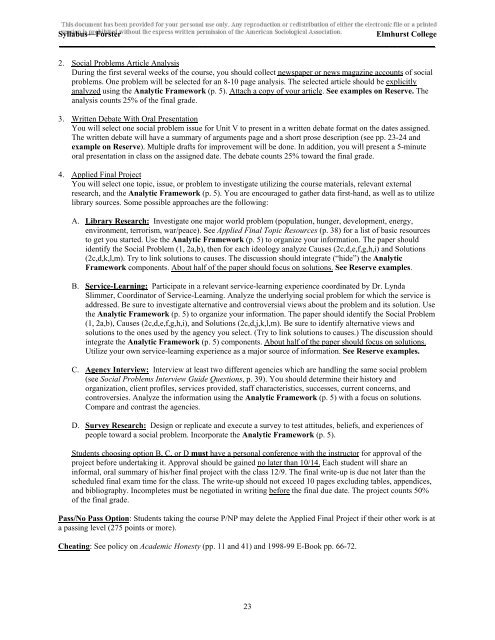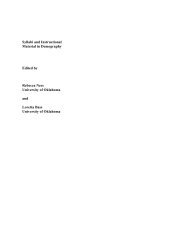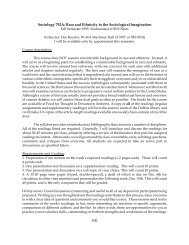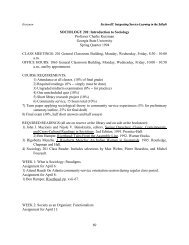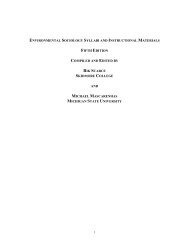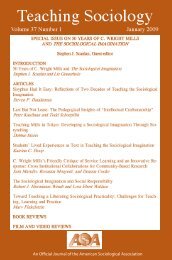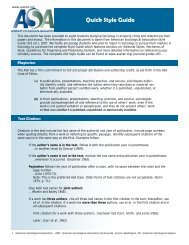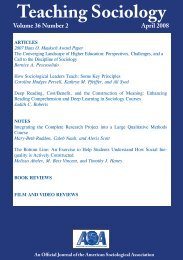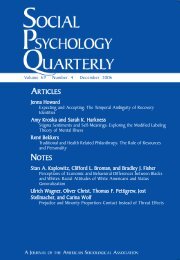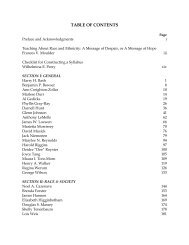Social Problems - American Sociological Association
Social Problems - American Sociological Association
Social Problems - American Sociological Association
You also want an ePaper? Increase the reach of your titles
YUMPU automatically turns print PDFs into web optimized ePapers that Google loves.
Syllabus—Forster Elmhurst College<br />
_____________________________________________________________________________________________<br />
2. <strong>Social</strong> <strong>Problems</strong> Article Analysis<br />
During the first several weeks of the course, you should collect newspaper or news magazine accounts of social<br />
problems. One problem will be selected for an 8-10 page analysis. The selected article should be explicitly<br />
analyzed using the Analytic Framework (p. 5). Attach a copy of your article. See examples on Reserve. The<br />
analysis counts 25% of the final grade.<br />
3. Written Debate With Oral Presentation<br />
You will select one social problem issue for Unit V to present in a written debate format on the dates assigned.<br />
The written debate will have a summary of arguments page and a short prose description (see pp. 23-24 and<br />
example on Reserve). Multiple drafts for improvement will be done. In addition, you will present a 5-minute<br />
oral presentation in class on the assigned date. The debate counts 25% toward the final grade.<br />
4. Applied Final Project<br />
You will select one topic, issue, or problem to investigate utilizing the course materials, relevant external<br />
research, and the Analytic Framework (p. 5). You are encouraged to gather data first-hand, as well as to utilize<br />
library sources. Some possible approaches are the following:<br />
A. Library Research: Investigate one major world problem (population, hunger, development, energy,<br />
environment, terrorism, war/peace). See Applied Final Topic Resources (p. 38) for a list of basic resources<br />
to get you started. Use the Analytic Framework (p. 5) to organize your information. The paper should<br />
identify the <strong>Social</strong> Problem (1, 2a,b), then for each ideology analyze Causes (2c,d,e,f,g,h,i) and Solutions<br />
(2c,d,k,l,m). Try to link solutions to causes. The discussion should integrate (“hide”) the Analytic<br />
Framework components. About half of the paper should focus on solutions. See Reserve examples.<br />
B. Service-Learning: Participate in a relevant service-learning experience coordinated by Dr. Lynda<br />
Slimmer, Coordinator of Service-Learning. Analyze the underlying social problem for which the service is<br />
addressed. Be sure to investigate alternative and controversial views about the problem and its solution. Use<br />
the Analytic Framework (p. 5) to organize your information. The paper should identify the <strong>Social</strong> Problem<br />
(1, 2a,b), Causes (2c,d,e,f,g,h,i), and Solutions (2c,d,j,k,l,m). Be sure to identify alternative views and<br />
solutions to the ones used by the agency you select. (Try to link solutions to causes.) The discussion should<br />
integrate the Analytic Framework (p. 5) components. About half of the paper should focus on solutions.<br />
Utilize your own service-learning experience as a major source of information. See Reserve examples.<br />
C. Agency Interview: Interview at least two different agencies which are handling the same social problem<br />
(see <strong>Social</strong> <strong>Problems</strong> Interview Guide Questions, p. 39). You should determine their history and<br />
organization, client profiles, services provided, staff characteristics, successes, current concerns, and<br />
controversies. Analyze the information using the Analytic Framework (p. 5) with a focus on solutions.<br />
Compare and contrast the agencies.<br />
D. Survey Research: Design or replicate and execute a survey to test attitudes, beliefs, and experiences of<br />
people toward a social problem. Incorporate the Analytic Framework (p. 5).<br />
Students choosing option B, C, or D must have a personal conference with the instructor for approval of the<br />
project before undertaking it. Approval should be gained no later than 10/14. Each student will share an<br />
informal, oral summary of his/her final project with the class 12/9. The final write-up is due not later than the<br />
scheduled final exam time for the class. The write-up should not exceed 10 pages excluding tables, appendices,<br />
and bibliography. Incompletes must be negotiated in writing before the final due date. The project counts 50%<br />
of the final grade.<br />
Pass/No Pass Option: Students taking the course P/NP may delete the Applied Final Project if their other work is at<br />
a passing level (275 points or more).<br />
Cheating: See policy on Academic Honesty (pp. 11 and 41) and 1998-99 E-Book pp. 66-72.<br />
23


